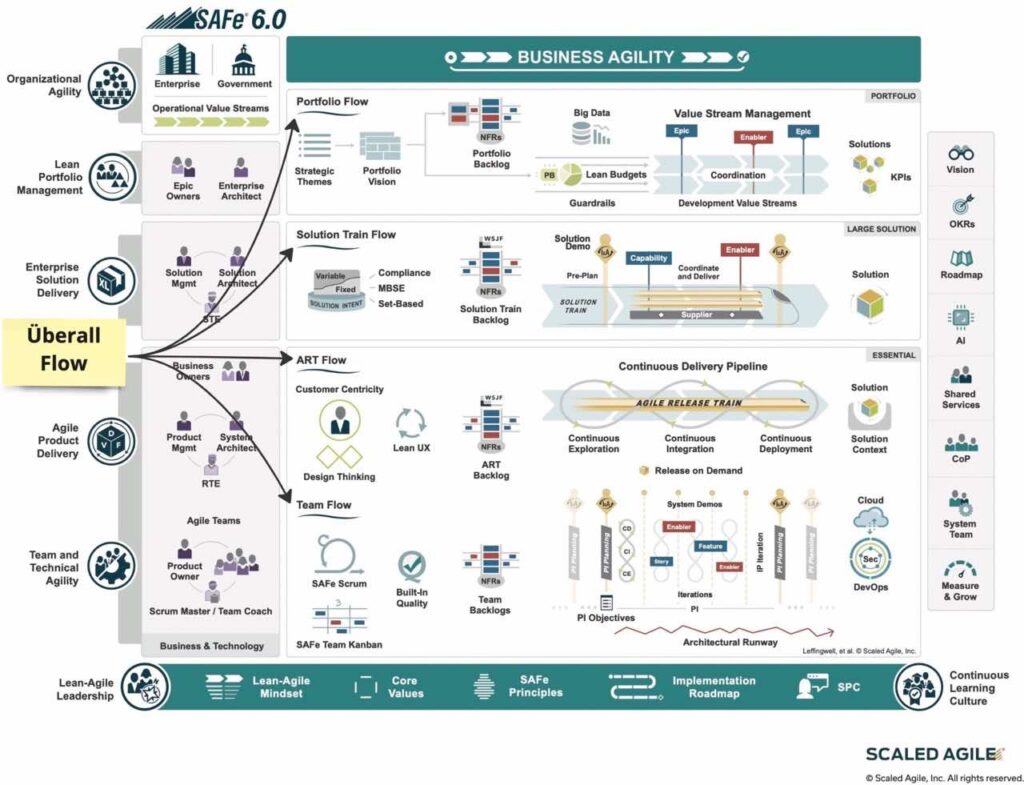We are of the opinion that SAFe and Kanban can learn from each other. The idea was triggered by the SAFe 6.0 update, which emphasizes "flow", i.e. the acceleration of flow, as a key aspect. First of all, it is important to us that we do not water down frameworks and methods. However, we are convinced that SAFe Transformation can become even better with an understanding of the Kanban change management methodology.
SAFe 6.0
In our view, the most important changes in the SAFe 6.0 Framework the acceleration of the flow of results. "Flow" now appears several times: Team Flow, ART Flow, Solution Train Flow, Portfolio Flow. That's all well and good, but what exactly is this "flow"? And how do we get there? We want to take a closer look at these aspects here.

Do you need a more detailed update before continuing with the text? In the Blog article "SAFe 6.0: More flow and business agility in the Scaled Agile Framework" Malte has summarized and explained the changes in the SAFe 6.0 update.
Scaling and flow control
Topics such as agile scaling and Kanban are among our core competencies at wibas. As a SAFe Practice Consultant, Franziska has been working in depth on scaling since she joined wibas. Julia and Astrid are two accredited Kanban trainers. We agree: If you understand Kanban, your SAFe will be better.
Here we want to tell you about our findings on how SAFe can be better implemented as a kind of "knowledge encyclopedia" as soon as Kanban has been penetrated as a change management method.
How did we actually come up with Kanban in this context?
Getting work flowing is an essential aspect of the Kanban change management method and part of the six Kanban practices. The flow of work is controlled and optimized by visualizing and limiting parallel work. For this to work, explicit agreements, regular feedback loops and joint improvement through experimentation are essential.
Agility is delivering the right work at the right time.
Managed replenishment and delivery options maximize agility.
In complicated and complex working environments, we want to ensure that we work on the right things at the right time and can react quickly to changes by managing the flow of work.
Kanban uses various metrics to make the actual flow of work measurable. System lead time, customer lead time, flow efficiency and more are all metrics that are used in the Kanban method in connection with flow control. Lead time distribution can be used to determine delays. This is the first step in better understanding system delays caused by dependencies, for example, and being able to mitigate them in the next step.

Kanban helps to uncover bottlenecks. You could also say: Kanban helps to find out where our work flow comes to a standstill. Understanding the nature and location of these bottlenecks influences how we act as a Kanban team. According to Goldratt's Theory of Constraints, the throughput of a system is limited by at least one bottleneck. This means that a system as a whole can only move as fast as the slowest process step.
That's quite nice. How does that help us with SAFe now?
The innovations in the SAFe 6.0 framework are aimed at streamlining the delivery process so that the right value is delivered to the customer in the shortest possible time. In other words, they aim to deliver the right thing at the right time (you remember? 😉). This applies to all levels of SAFe: Team, Agile Release Train (ART), Solution Train and Portfolio. These updates help organizations respond quickly to market demands and better serve their customers.
Theoretically understandable, but not yet catchy enough?
If you want to experience real "flow" and understand in practice in a short time what reads so simple in theory, then take a look at our simulations. True to the motto: Experience agility instead of talking about it.
Do you have any questions about Kanban or SAFe? Then take a look at our academy:
- wibas Kanban trainings
- wibas SAFe trainings (of course with all information about SAFe 6.0)
Questions?
Write to us, we look forward to hearing from you!

Write a comment